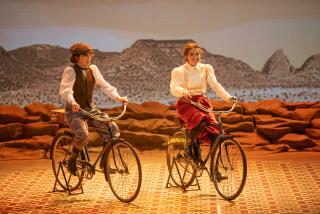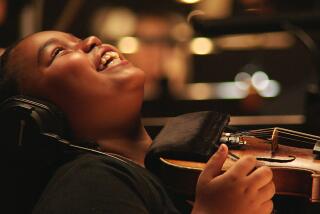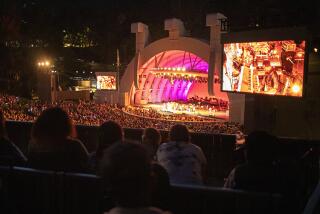Art or commerce? Behind the music with ‘La La Land’ session musicians Peter Erskine and Randy Kerber

The esteemed jazz drummer Peter Erskine, whose playing is featured across the score of the hit movie musical “La La Land,” has a tip for snobby young jazz players who, like the fictional Seb (Ryan Gosling), are gunning to make it as musicians but are wary of for-hire gigs.
“I look at every playing opportunity as a blessing not a curse — and I’ve done plenty of dumb gigs” says Erskine, who in addition to making his own albums and working on Hollywood movies, is a professor at USC’s Thornton School of Music.
“La La Land” — nominated for 14 Oscars, including three for composer Justin Hurwitz’s original score and songs — explores the tension of creative people trying to make a living through art.
At the heart of the film is a love story between the pianist and a budding actress, Mia (Emma Stone), but flowing through are questions about fate, financial freedom and creative conviction. Guiding it all is a score that adds layers of unspoken nuance — to say nothing of the vocal bursts that arrive with the song-and-dance.
Hurwitz and writer-director Damien Chazelle achieved this by harnessing the skills of L.A. session players who have also had to wrestle with making behind-the-scenes art in service of a paycheck.
In fact, peel back the fiction of the story and what remains are real musicians who have contended with similar issues as Seb. One pivotal scene at a pool party, for example, sees the self-serious artist kowtowing on a key-tar as part of a cheesy new wave cover band.
“I can relate to trying to make a living playing jazz — or, you know, ‘pure’ jazz, as it is,” says pianist Randy Kerber, whose real-life fingers dotted out the rich piano lines played by Gosling in the film.
Kerber, who grew up in Reseda, composed and played jazz piano in high school and performed at the Monterey Jazz Festival while still a teen. He got his break, though, not as a young-gun gigging at the Village Vanguard, but as part of singer Bette Midler’s backing band.
“Jazz purists can be quick to judge any other kind of music,” says Kerber, “and it sets them apart but also puts a little bit of a chip on their shoulder.”
Still, one particular moment for Seb, says Kerber, resonated: “You know the scene where all of a sudden the drum machine starts and he stops and he’s got that great look on his face?” Kerber’s been there.
Since moving to film work in the early 1980s, Kerber’s playing has been heard on the scores to blockbusters such as “The Color Purple,” “Forrest Gump,” “Titanic” and “Star Wars: The Force Awakens.” At the other end of the spectrum, he’s earned income from dozens of lesser movies including “The Intern,” “Dinner for Schmucks” and “Reno 911: Miami!”
Don’t judge, says Erskine.
Asked what advice he’d give Seb, who in a defining scene is shown lazily playing rote versions of Christmas carols in a restaurant instead of the Thelonius Monk-inspired music that drives him, Erskine says, “Every playing opportunity informs the next one. You might learn something profound about just how to work with other musicians, or what to do when a song starts to fall apart on the bandstand.”
This from a man who, while best known for his work with Weather Report and Steps Ahead, has earned paychecks from jobs on such cinematic gems as “Austin Powers: The Spy Who Shagged Me,” “Miss Congeniality 2: Armed and Fabulous” and “Cats & Dogs: The Revenge of Kitty Galore.”
“La La Land” composer Hurwitz says that he had to pound the pavement like most who make it in Hollywood, with a caveat: “I can’t really say I was a struggling musician because I realized early on that I should just not be a musician.”
Speaking on the phone while on a break from shooting the HBO series “Curb Your Enthusiasm,” where he is a writer, Hurwitz adds that he and Chazelle once did make a go of it as pop stars — while attending Harvard.
Both were members of Chester French, a band that ultimately provoked a bidding war in the early ’00s between Kanye West and Pharrell Williams. By then, though, Hurwitz had quit the band and set his sights on Los Angeles. (Former Chester French vocalist D.A. Wallach plays a new wave singer in “La La Land.”)
“When I first moved out to L.A., I was expecting things to pick up quickly,” says Hurwitz. “But I decided in those first few years to not pursue other movies and just focus really, really hard on Damien’s movies — and I’m very glad I did, obviously.”
For “La La Land,” Hurwitz and his team recorded the orchestra on the Sony lot but moved to the modest Conway Studios on Melrose Avenue for the jazz and small-band work with Erskine, Kerber and fellow session experts including trumpeter Wayne Bergeron, bassist Kevin Axt, trombonist Andy Martin, guitarist Graham Dechter and others.
There, they set about capturing the spontaneity of improvised music within a highly controlled setting.
“It’s fun being directed and feeling that I’m in some way embodying the emotion of the character in the movie. I kind of try to put myself in his shoes,” says Kerber.
He cites as an example “Deck the Halls,” which Gosling’s Seb indelicately, defiantly plays at the restaurant on orders from his boss.
Singing through the melody, Kerber keys in on a single note that he played, one that conveyed Seb’s frustrated ambivalence. “It’s like he gives the finger to the song. Those are the things that I can try and interject.”
For his part, Erskine noted his drum fill during the choreographed opening scene. Called in by “La La Land” executive music producer Marius de Vries to add percussion, the musician struggled with getting the right tone.
“I remember him saying, ‘I want more violent chords — violent rhythms,’” says Erskine. “And that’s just not a word I’ve ever heard in the production of a jazz recording.”
Erskine repeatedly worked on the pattern while adjusting to De Vrie’s suggestions. “I got to the point where I was like, ‘Here’s your big fill,’ and I played it angry.” Erskine could hear his emotions when he first saw the scene.
He could also hear something else. After asking who would be playing his onscreen counterpart, Erskine was told to sound like “a young drummer trying to make an impression.”
Erskine adjusted his approach, putting himself in the mind-set, he said, “of how I imagine some of my students at USC. They’re young, skinny guys wearing skinny ties trying to burn it up.”
The onscreen drummer in “La La Land,” though, didn’t end up being a Seb-like hotshot. “It’s a sixtysomething dude sitting behind the drums like an old man,” says Erskine.
Chuckling, he adds, “That’s just not the way an older gentleman would play the drums.”
For tips, records, snapshots and stories on Los Angeles music culture, follow Randall Roberts on Twitter and Instagram: @liledit. Email: randall.roberts@latimes.com.
More to Read
The biggest entertainment stories
Get our big stories about Hollywood, film, television, music, arts, culture and more right in your inbox as soon as they publish.
You may occasionally receive promotional content from the Los Angeles Times.







